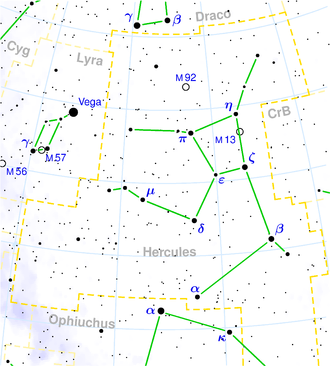IC 1223
| Galaxie IC 1223 | |
|---|---|
![IC 1223[1] SDSS-Aufnahme](http://upload.wikimedia.org/wikipedia/commons/thumb/0/08/IC1223_-_SDSS_DR14.jpg/300px-IC1223_-_SDSS_DR14.jpg) | |
| IC 1223[1] SDSS-Aufnahme | |
| AladinLite | |
| Sternbild | Herkules |
| Position Äquinoktium: J2000.0, Epoche: J2000.0 | |
| Rektaszension | 16h 35m 42,464s[2] |
| Deklination | +49° 13′ 13,94″[2] |
| Erscheinungsbild | |
| Morphologischer Typ | SB[3] |
| Helligkeit (visuell) | 14,4 mag[3] |
| Helligkeit (B-Band) | 15,2 mag[3] |
| Winkelausdehnung | 0,90' × 0,7'[3] |
| Positionswinkel | 18°[3] |
| Flächenhelligkeit | 13,7 mag/arcmin²[3] |
| Physikalische Daten | |
| Rotverschiebung | 0.029747 ± 0.000163[2] |
| Radialgeschwindigkeit | 8918 ± 49 km/s[2] |
| Hubbledistanz vrad / H0 | (406 ± 28) · 106 Lj (124,5 ± 8,7) Mpc [2] |
| Geschichte | |
| Entdeckung | Lewis Swift |
| Entdeckungsdatum | 11. Juli 1890 |
| Katalogbezeichnungen | |
| IC 1223 • PGC 58567 • CGCG 251-032 • MCG +08-30-033 • 2MASX J16354249+4913137 • GALEXASC J163542.48+491313.5 • LDCE 1204 NED001 • WISEA J163542.45+491313.8 | |
IC 1223 ist eine Balken-Spiralgalaxie vom Hubble-Typ SB im Sternbild Herkules am Nordsternhimmel. Sie ist schätzungsweise 406 Millionen Lichtjahre von der Milchstraße entfernt und hat einen Durchmesser von etwa 105.000 Lichtjahren.
Das Objekt wurde am 11. Juli 1890 von Lewis Swift entdeckt.[4]
Siehe auch
Weblinks
Einzelnachweise
Auf dieser Seite verwendete Medien
Autor/Urheber: Sloan Digital Sky Survey, Lizenz: CC BY 4.0
The sky image is obtained by Sloan Digital Sky Survey, DR14 with SciServer.
Angle of view: 4' × 4' (0.3" per pixel), north is up.
Details on the image processing pipeline: https://www.sdss.org/dr14/imaging/jpg-images-on-skyserver/



